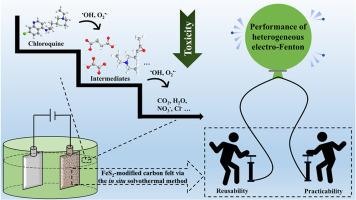通过产生-OH和O2的黄铁矿改性电-芬顿高效降解氯喹
IF 9.7
1区 环境科学与生态学
Q1 ENGINEERING, ENVIRONMENTAL
引用次数: 0
摘要
随着氯喹(CLQ)的大量生产和消费,由于其生物累积性和持久性,CLQ 的存在对水环境和生物体构成了严重威胁。本研究以黄铁矿改性碳毡(EF-FeS2-CF)为阴极,构建了一个异相电-芬顿系统来去除 CLQ。结果表明,EF-FeS2-CF 在 20 mA 电流下 30 分钟后对 5 mg/L CLQ 的去除率为 92.4±0.1%,在各种操作条件下对 CLQ 的去除均表现出卓越的催化性能,并且具有极低的铁浸出率和良好的可回收性(所有五次循环实验的 30 分钟 CLQ 去除率均为 90%,累计铁损耗仅为 0.3%),在不同水环境中具有显著的应用潜力,无需调节 pH 值。研究发现,O2--和-OH 对 CLQ 的降解都有很大的促进作用,而后者起着主要作用(CLQ 去除率达 50%)。为了描述CLQ在EF-FeS2-CF中完全矿化的降解过程,根据生态毒性通常较低的主要降解中间体,提出了三种CLQ降解途径。因此,这种 EF-FeS2-CF 系统在处理含有 CLQ 的水体方面具有广阔的应用前景。本文章由计算机程序翻译,如有差异,请以英文原文为准。

Efficient degradation of chloroquine via pyrite-modified electro-Fenton yielding •OH and O2•-
In the face of the mass production and consumption of chloroquine (CLQ), the presence of CLQ has posed a significant threat to the water environment and living organisms due to its bio-accumulative and persistent nature. In this work, a heterogeneous electro-Fenton system using a pyrite-modified carbon felt as the cathode (EF-FeS2-CF) was constructed to remove CLQ. EF-FeS2-CF was found to achieve 92.4±0.1% removal of 5 mg/L CLQ after 30 min at 20 mA and exhibited an outstanding catalytic performance for CLQ removal in wide ranges of operating conditions, excellent recyclability with low iron leaching (> 90% 30-min CLQ removal efficiency for all five cyclic experiments which led to only an accumulative Fe loss of < 0.3%) and remarkable application potential in different aqueous environments without any pH adjustment. Both O2•- and •OH were found to greatly contribute to CLQ degradation while the latter played a major role (> 50% CLQ removal). To describe CLQ degradation towards complete mineralization in EF-FeS2-CF, three CLQ degradation paths were proposed based on the main degradation intermediates identified with generally lower ecotoxicities. Such an EF-FeS2-CF system therefore presents promising application potential to treat CLQ-laden waters.
求助全文
通过发布文献求助,成功后即可免费获取论文全文。
去求助
来源期刊

Journal of Cleaner Production
环境科学-工程:环境
CiteScore
20.40
自引率
9.00%
发文量
4720
审稿时长
111 days
期刊介绍:
The Journal of Cleaner Production is an international, transdisciplinary journal that addresses and discusses theoretical and practical Cleaner Production, Environmental, and Sustainability issues. It aims to help societies become more sustainable by focusing on the concept of 'Cleaner Production', which aims at preventing waste production and increasing efficiencies in energy, water, resources, and human capital use. The journal serves as a platform for corporations, governments, education institutions, regions, and societies to engage in discussions and research related to Cleaner Production, environmental, and sustainability practices.
 求助内容:
求助内容: 应助结果提醒方式:
应助结果提醒方式:


